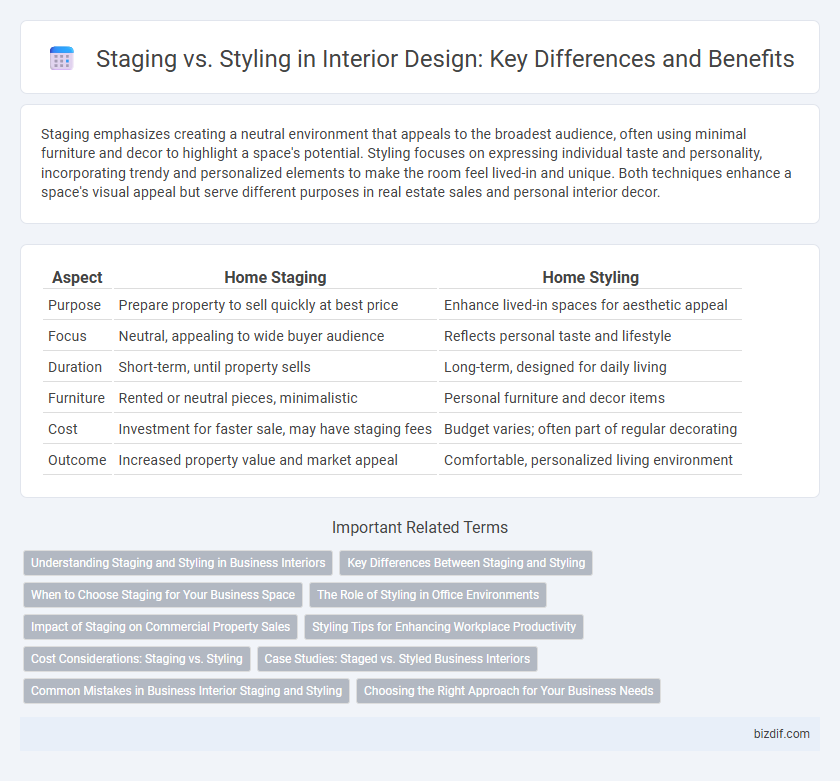Staging emphasizes creating a neutral environment that appeals to the broadest audience, often using minimal furniture and decor to highlight a space's potential. Styling focuses on expressing individual taste and personality, incorporating trendy and personalized elements to make the room feel lived-in and unique. Both techniques enhance a space's visual appeal but serve different purposes in real estate sales and personal interior decor.
Table of Comparison
| Aspect | Home Staging | Home Styling |
|---|---|---|
| Purpose | Prepare property to sell quickly at best price | Enhance lived-in spaces for aesthetic appeal |
| Focus | Neutral, appealing to wide buyer audience | Reflects personal taste and lifestyle |
| Duration | Short-term, until property sells | Long-term, designed for daily living |
| Furniture | Rented or neutral pieces, minimalistic | Personal furniture and decor items |
| Cost | Investment for faster sale, may have staging fees | Budget varies; often part of regular decorating |
| Outcome | Increased property value and market appeal | Comfortable, personalized living environment |
Understanding Staging and Styling in Business Interiors
Staging in business interiors involves preparing a commercial space to appeal to potential buyers or clients by showcasing its functionality and maximizing its market value. Styling focuses on enhancing the existing design through aesthetic touches like furniture arrangement, color schemes, and decor to create an inviting atmosphere aligned with brand identity. Understanding the distinct roles of staging and styling helps businesses optimize interior presentation for sales success and customer engagement.
Key Differences Between Staging and Styling
Staging transforms a property to appeal broadly to potential buyers, emphasizing neutrality and space optimization for resale value, while styling enhances personal living spaces with curated decor reflecting individual taste. Staging typically involves minimal furniture and neutral palettes to create a blank canvas, whereas styling incorporates bold colors, unique accessories, and personalized themes to express lifestyle. The key difference lies in staging's goal to sell homes efficiently contrasted with styling's focus on creating inviting, lived-in environments.
When to Choose Staging for Your Business Space
Choosing staging for your business space is essential when aiming to create a polished, universal appeal that attracts potential buyers or clients quickly. Staging emphasizes neutral, functional layouts and minimalistic decor to highlight the space's versatility, making it easier for viewers to envision their own use. This approach is particularly effective in commercial real estate and office environments where first impressions and spatial adaptability drive leasing or sale decisions.
The Role of Styling in Office Environments
Styling in office environments enhances brand identity and boosts employee morale through curated furniture, color schemes, and artwork that reflect company culture. Unlike staging, which aims to sell or lease spaces quickly, styling creates a lasting, functional atmosphere tailored to daily professional needs. Effective office styling incorporates ergonomic design and technology integration, promoting productivity and comfort.
Impact of Staging on Commercial Property Sales
Staging significantly boosts commercial property sales by creating visually appealing spaces that highlight functionality and potential, attracting more prospective buyers. Strategic use of furniture, lighting, and decor helps showcase the property's best features, often resulting in faster sales and higher offers. Effective staging transforms empty or outdated commercial spaces into inviting environments that facilitate buyer visualization and decision-making.
Styling Tips for Enhancing Workplace Productivity
Effective workplace styling incorporates ergonomic furniture, natural lighting, and clutter-free environments to boost employee focus and comfort. Incorporating plants and calming color palettes can reduce stress and increase creativity, while personalized desk accessories promote a sense of ownership and motivation. Strategic placement of functional decor and organizational tools enhances workflow efficiency and overall workplace satisfaction.
Cost Considerations: Staging vs. Styling
Staging typically involves higher upfront costs due to professional rental furniture, artwork, and full-room setups designed to appeal broadly to potential buyers. Styling is more budget-friendly, often using existing furnishings and decorative accents to enhance a space's aesthetic without substantial investment. Understanding these cost considerations helps homeowners choose between impactful market-ready staging or cost-effective style enhancements for interior design projects.
Case Studies: Staged vs. Styled Business Interiors
Case studies of staged versus styled business interiors reveal distinct impacts on client perception and space functionality. Staged interiors prioritize neutral, depersonalized settings designed to appeal to a broad audience, often resulting in quicker sales or leases, while styled interiors emphasize brand identity and aesthetic coherence, enhancing employee satisfaction and client engagement. Data shows staged spaces increase transaction speed by 30%, whereas styled interiors improve workplace productivity by up to 20%.
Common Mistakes in Business Interior Staging and Styling
Common mistakes in business interior staging and styling include overpersonalizing the space, which can alienate potential clients and employees, and neglecting functionality, leading to impractical layouts that hinder productivity. Another frequent error is ignoring the target audience's brand identity, resulting in designs that fail to convey the desired company image. Failing to balance aesthetics with comfort and usability often diminishes the overall effectiveness of the interior environment.
Choosing the Right Approach for Your Business Needs
Staging and styling serve distinct purposes in interior design, with staging primarily aimed at enhancing property appeal for sale by creating neutral, inviting spaces, while styling focuses on personalizing interiors to reflect individual taste and brand identity. Businesses should evaluate their goals: real estate agencies benefit from staging to boost marketability and shorten listing times, whereas lifestyle brands or retail clients gain from styling to craft memorable, cohesive environments that resonate with their audience. Selecting the right approach hinges on understanding target market expectations, project timelines, and desired emotional impact on potential buyers or customers.
Staging vs Styling Infographic

 bizdif.com
bizdif.com